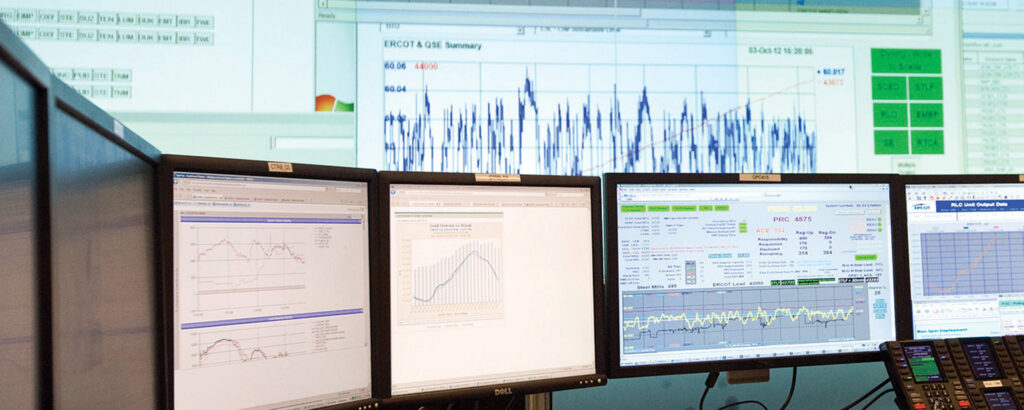Operating a reliable distribution system is more complex, challenging, and important than ever before. EPRI research is identifying and sharing the skills operators need to do it well.
Public policy, regulations, and technology developments often dominate discussions about the ongoing and rapid transformation of the power system. Incentives and mandates that flow out of state renewable portfolio standards and the recently passed Inflation Reduction Act are big drivers of demand for commercial and residential purchase and interconnection of distributed energy resources (DERs), such as rooftop solar and battery energy storage. Advances in the performance and availability of technologies like electric vehicles (EVs) and heat pumps also attract attention.
Often, market forecasts and the deliberations of state and federal legislators and regulators can come across as abstract and removed from the daily responsibilities of utility workers. But there is nothing abstract about the significant impact the transition to a more decentralized and decarbonized grid will have on the role of distribution system operators. Increasingly, utilities understand that they must proactively equip control room staff with the skills and technologies necessary to operate a resilient, complex, and ever more important distribution grid.
A Role Transformed
To understand the velocity of change and increased complexity that distribution control center operators face today, it’s helpful to remember that their past responsibilities were important but straightforward. Often referred to as dispatchers, operators responded to customer outages by directing crews to perform repairs and get service back up and running. The tools necessary to perform that task were far from high-tech.
“Historically, operators worked off a paper map with a one-line diagram that had a very simplified expression of the distribution system with enough details for the operator to direct a crew to an address or a device to do their repair work,” said Nick Heine, an EPRI technical leader and co-author of the recent EPRI report Distribution Operational Planning: Expanding the Capabilities of a Modern Control Center. “Dispatchers usually came from a career in field operations, and their job was to ensure safe and reliable service for utility customers.”
At its core, the mission of distribution operations today is the same as it always has been. But the dramatic and accelerating transformation of the distribution system is fundamentally redefining the skills operators must possess to do the job well. For example, deployments of DERs are quickly growing. The research firm Wood Mackenzie forecasts that cumulative DER capacity in the U.S. alone will reach nearly 400 gigawatts by 2025. This influx of solar, batteries, and other DERs can substantially benefit the distribution grid. For example, the operation of DERs in aggregate may help meet peak demand, and their interconnection may delay or eliminate the need for expensive grid upgrades.
But DERs can also pose a challenge for distribution operators. A large concentration of DERs on a feeder, for instance, has the potential to negatively impact power quality and threaten safe voltage and frequency limits. Distribution operators are also increasingly charged with optimizing grid reliability and safety by using the massive volume of data utilities collect. For instance, the U.S. Energy Information Administration (EIA) reported that 111 million smart meters had been installed in the U.S. at the end of 2021. Any distribution control center would be challenged to make sense of all the data produced by sensors, smart meters, and DERs.
New Tools: More Insights, More Complexity
New tools have emerged to help distribution operators with tasks such as managing the two-way power flows of DERs and ensuring feeder-level safety and reliability. Instead of one-line diagrams, for instance, many utilities have adopted distribution management systems (DMS) that digitize their view of the distribution grid and provide a range of new capabilities.
“You can now have measurements from the SCADA [supervisory control and data acquisition system] at the substation that might show volts and amps at a specific location,” said Lindsey Rogers, who runs EPRI’s distribution operations and planning research program. “Many operators are working with a DMS that has a full-blown electrical model that allows them to run sophisticated analysis and have a dynamic view of the distribution grid.”
Other tools have also emerged with the potential to help operators manage an increasingly complex distribution system. DER management systems (DERMS) provide operators with the visibility and control needed to dispatch and curtail DERs to both maximize their grid reliability and decarbonization benefits and allow more assets to be interconnected to the distribution system. Distribution automation devices also autonomously control switches on the grid, replacing the historical practice of dispatchers calling field crews to manually operate the switches.
At one level, the rapid change driven by digitization and automation can be seen as lessening the responsibilities and workload of operators—a belief embraced by some utility decision makers. “There are senior managers at utilities who think that automation and management systems make things easier for operators and that they need fewer people,” Rogers said. “What we are seeing, with all of the distribution system changes, is that the rubber meets the road with the operators. These changes require that operators have a new skill set and role in how the system is being managed on a day-to-day basis.”
The Need for Distribution Operational Planning
Through its research and collaboration with members, EPRI is working to identify the skills and roles needed in a modern distribution control center. EPRI is also developing training and courses provided by EPRI|U to ensure that utility personnel acquire the necessary skills.
One important new role is distribution operational planning. Operational planning is already a common job in transmission operations, where planners make decisions to prepare the grid to operate reliably in the near and longer term. Among the tasks of transmission planners are scheduling maintenance and repair work so as not to impact system reliability, assessing risks associated with forecasted grid conditions, and coordinating with neighboring grid operators and distribution utilities.
Distribution control centers traditionally haven’t needed in-house planners. But that has changed. “Operational planners are a bridge between real-time operations and the planning and protection groups that do technical analysis,” Heine said. “As we make the distribution system more dynamic and automated, we need engineering support in the control center, which has recently been provided on an ad hoc or on-call basis. Now distribution control centers need dedicated staff to provide engineering support around the clock.”
Tools like DMS and DERMS rely on accurate and continuously updated distribution system models. To be effective, distribution operational planners will need to be able to create and maintain these models. “Building and maintaining electrical models requires a lot of resources. Traditional planners have the benefit of time and can take three months or a year to run studies and propose grid upgrades,” Heine said. “But operators have three minutes or 30 minutes to make a decision, which is why it’s so critical to have up-to-date models.”

Fast Decisions in a Dynamic Environment
Updated and accurate models paired with the right skills can empower operators to navigate the complexities of a modern distribution system. For instance, traditional DER interconnection studies present a picture of the grid under typical conditions. But changes such as the ability to participate in wholesale markets made possible by Federal Energy Regulatory Commission (FERC) Order 2222 mean that DERs will increasingly be operating under abnormal conditions. For operators, the influx of DERs and their participation in wholesale markets require hosting capacity analysis that considers short-term generation and load forecasts.
The ability to respond to quickly changing conditions will be essential to maintain grid reliability. “It’s about taking some of the roles of the planning department and bringing them into the real-time environment of the control center,” Rogers said. “It’s not second by second, but a day ahead or a week ahead, and having the skills in the control room to do loading assessments and evaluate if the grid can handle EV charging or heat pumps. That is critically important so that operators can make decisions to help customers and avoid outages.”
EPRI’s work to provide the skills modern distribution system operators need is ongoing. Already, EPRI|U offers several online courses that delve into topics like volt/var management and DMS training. This year EPRI is investigating the training and testing that would be required to provide certification that operators have the necessary skills and competencies—a step that would drive consistency across the industry. And later this year, EPRI will release a white paper that defines the operator skills and control center capabilities to meet the requirements of FERC Order 2222.
Ultimately, the goal of EPRI’s work in this area is to support the training and knowledge needed for utilities to keep pace with distribution system changes. “The rate of change in the distribution system with customer and utility adoption of technologies is so fast that the current operators can’t keep up,” Heine said. “We are addressing that issue by identifying the skills and tools that will benefit utilities. And it’s a two-sided coin. Technology adoption challenges utilities, but it also presents a big opportunity. The intersection of those two is where operational planning can benefit the industry.”
EPRI Technical Expert:
Nick Heine
For more information, contact techexpert@eprijournal.com.


